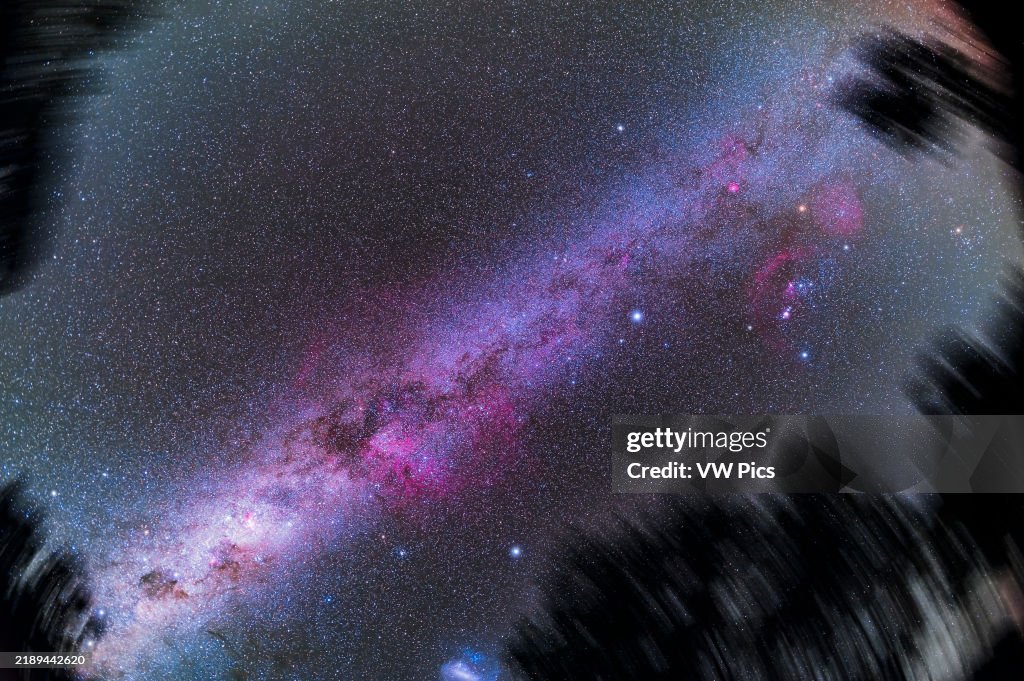Southern Milky Way from Crux to Orion
This is a wide-angle view of the southern Milky Way, here from Carina and Crux at lower left up to Orion and Monoceros at upper right. This was shot from latitude 31° S on an austral autumn night, March 3, 2024. The two brightest stars in the night sky are in the frame: Sirius right of centre and Canopus at bottom. In the centre are the constellations of Puppis and Vela, marked by the large circular Gum Nebula complex, a supernova remnant. The image was processed to enhance the pink and red nebulosity in this rich area of sky, around Orion at top and in the Vela-Puppis area. The image demonstrates just how much brighter the Milky Way is in Carina and Crux at lower left than it is farther north in Puppis, Canis Major and Monoceros. Taken with a filter-modified Canon Ra camera, but no filter per se was used other than a clip-in Astronomik UV/IR-Cut filter to reduce the haloes on bright stars that the Ra is prone to. Oddly, using this filter also improves the off-axis sharpness of the lens used here, an 11mm TTArtisan full-frame fish-eye, wide open at f/2.8, but re-focused closer than infinity to obtain sharp stars with the clip-in filter. All on the MSM Nomad tracker, for a stack of 10 x 3-minute exposures at ISO 800. Taken on a perfect night March 3, 2024 from Mirrabook Cottage near Coonabarabran, NSW, Australia, near the Warrumbungles National Park. (Photo by: Alan Dyer/VWPics/Universal Images Group via Getty Images)

PURCHASE A LICENSE
How can I use this image?
$375.00
CAD
Getty ImagesSouthern Milky Way from Crux to Orion, News Photo Southern Milky Way from Crux to Orion Get premium, high resolution news photos at Getty ImagesProduct #:2189442620
Southern Milky Way from Crux to Orion Get premium, high resolution news photos at Getty ImagesProduct #:2189442620
 Southern Milky Way from Crux to Orion Get premium, high resolution news photos at Getty ImagesProduct #:2189442620
Southern Milky Way from Crux to Orion Get premium, high resolution news photos at Getty ImagesProduct #:2189442620$575$175
Getty Images
In stockPlease note: images depicting historical events may contain themes, or have descriptions, that do not reflect current understanding. They are provided in a historical context. Learn more.
DETAILS
Restrictions:
Contact your local office for all commercial or promotional uses.
Credit:
Editorial #:
2189442620
Collection:
Universal Images Group
Date created:
March 03, 2024
Upload date:
License type:
Release info:
Not released. More information
Source:
Universal Images Group Editorial
Object name:
1020_08_ady-june2024-124
Max file size:
6710 x 4460 px (22.37 x 14.87 in) - 300 dpi - 14 MB
- Betelgeuse - Star,
- Astronomy,
- Astrophotography,
- Australia,
- Canis Major,
- Carina Nebula,
- Clip-In Hair Extensions,
- Color Image,
- Constellation,
- Emission Nebula,
- Galaxy,
- Horizontal,
- Human Interest,
- Long Exposure,
- Milky Way,
- Nebula,
- New South Wales,
- Night,
- Observatory,
- Orion - Constellation,
- Orion Nebula,
- Outer Space,
- Photography,
- Sirius,
- Sky,
- Space and Astronomy,
- Telescope,
- Tracker,
- Warrumbungles,
- Wide Angle,
- Winter,